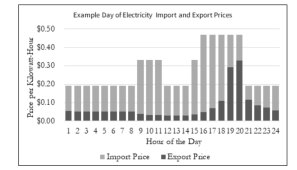So for NEM 1 the strategy was to produce as much power as you could durning peak times and use it at off-peak times, so for every kwh you put in the grid from noon to 6pm you got $0.32 credit which you could use at night at $0.085. So for every 1 kwh you put in at peak, you could take out 3 1/2 off peak and be even. The net would accumulate and be calculated at the end of the year. It also meant you could have a much smaller PV system and have a net of 0 at the end of the year.
So from what little I know of NEM 3, you basically don't get anything for putting power into the grid, which means you need to use as much power while you generate it and store any excess in a battery for use at night for use the same day. Also, you have to generate and store enough power for your worst (i.e. hottest day) and forget about any NET over the year? i.e. no winter credits for extra summer use? This also means you need a much bigger pv and battery system than a NEM 2 system, one that can take care of the "worst" (hottest=most power used) day?
A 10 or 20 kwh battery should be doable for most that have pv now. 100kwh is getting up there. Plus, if batteries go like panel and inverter prices, they will hopefully get better and cheaper in the future. I never considered that a 20 year panel warranty would be made useless by panels that are 2x as efficient that cost a fraction of what they once did. Throw them away (recycle) after 10-15 years and get new ones. Or put them to some other use and get new ones.
Mostly correct but you are missing a few nuances.
You don’t get $0.00 for excess export, you get $0.025, which is 13.16% of off-peak rates of $0.29:

Secondly, while NEM 1.0 and NEM 2.0 limited you up sn array sized to offset annual consumption, NEM 3.0 explicitly authorizes arrays sized to generate 150% of annual consumption.
Given the much higher power per panel coupled with the much lower cost per W of solar panels, this translates to 1.5 times the power for much less cost and roof real-estate that was the case for early NEM 1.0 customers.
So let’s now do the math with an assumption of flat consumption and a typical 100%, 150% 100%, 50% quarterly split of seasonal generation as a % of (flat) quarterly consumption for March-May, June-August, September-November, and December-February.
An array sized at 100% of annual consumption will approximately offset 100% of consumption from March through May (as well as from September through November).
Scaled to to an array sized at 150% of annual consumption means you will export +50% of consumption from March through May (and another +50% from September through November).
Over the June-August months, the 100% array would export +50% meaning the 150% array will export +75% on consumption.
So over those 9 months you’ll generate more than enough power daily to offset 24-hour consumption and will export a total of +50% + +60% + +75% of 3-month consumption, meaning a total of +175%.
But that +175% of consumption is only valued at 13.16% of wintertime consumption rates, meaning they are only valued as enough credit to offset 10% of winter months consumption.
A 100%-sized array would only offset 50% of consumption from December through February, meaning a 150%-sized array will offset 75%.
The 10% export credit generated from March through November covers 2/5ths of that gap, but the remaining 15% of wintertime consumption will need to be paid for.
The 15$/month minimum charge translates to $180 for the year or enough to cover 621kWh of consumption annually.
So as long as your monthly consumption is less than 207kWh / 15% = 1092kWh, you won’t owe anything more than the Minimum Delivery Charges you’ve already paid.
Of course if you consume much more per month over winter months versus non-winter months, that will change the math and things may not work out as well for you.
But overall, the larger array sized authorized under NEM 3.0 will translate to offsetting most of your winter consumption charges (beyond MDCs).



